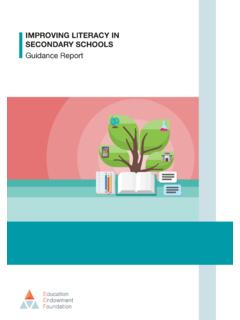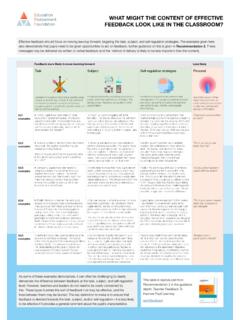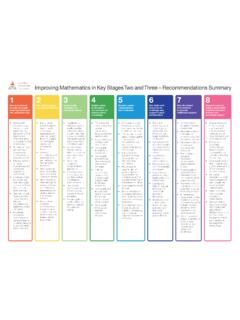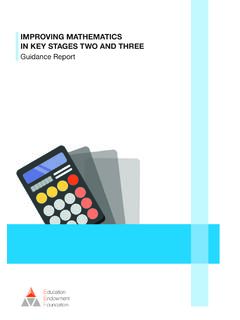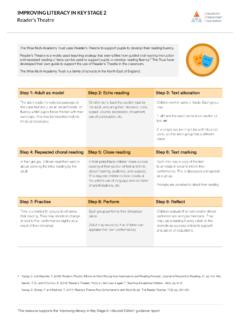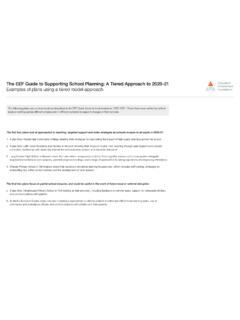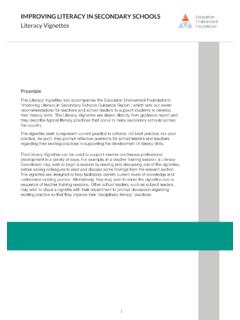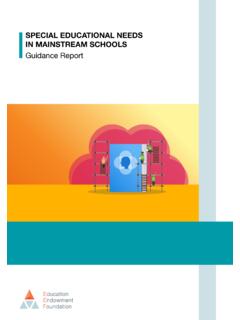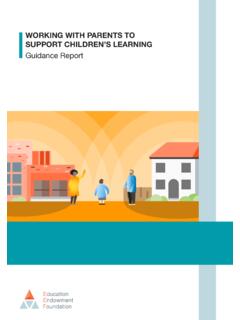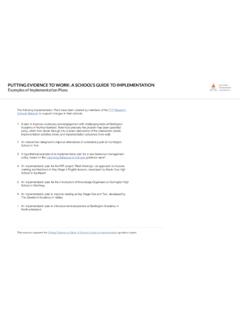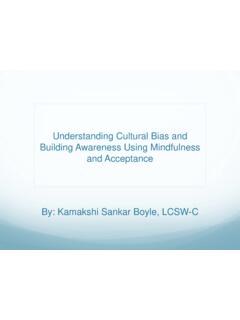Transcription of COGNITIVE SCIENCE APPROACHES IN THE CLASSROOM: A …
1 COGNITIVE SCIENCE APPROACHES IN THE CLASSROOM: A REVIEW OF THE EVIDENCE2 COGNITIVE SCIENCE APPROACHES in the classroom: a review of the evidenceThis report summarises the contents of a longer systematic, evidence and practice review produced by a team from the University of Birmingham, England. We would like to thank all those who have contributed or provided advice in the production of the original review, and this teacher facing summary. Review team: Dr Thomas Perry, Dr Rosanna Lea, Clara R bner J rgensen (University of Birmingham), Prof. Philippa Cordingley (CUREE), Prof. Kimron Shapiro, Prof. Deborah Youdell (University of Birmingham).Additional support in writing this practitioner summary was provided by Jonathan Kay and Harry Madgwick (EEF).We would also like to thank the advisory panel who assisted the review team. Advisory panel: Dr Robin Bevan, Prof.
2 Robert Coe, Dr Iroise Dumontheil, Dr Amy Fancourt, Dr Davinia Fern ndez-Espejo, Julia Harrington, Dr Niki Kaiser, Mark Stow, Prof. Hillevi Lenz Taguchi, Sonia Thompson, Prof. Sam the Education Endowment FoundationThe Education Endowment Foundation (EEF) is an independent charity supporting teachers and school leaders to use evidence of what works and what doesn t to improve educational outcomes, especially for disadvantaged children and young 20213 COGNITIVE SCIENCE APPROACHES in the classroom: a review of the evidenceCONTENTSF oreword 3 Executive summary 4 Introduction 9 Different aspects of COGNITIVE SCIENCE and how they might be applied in the classroom 1 Spaced learning152 Interleaving193 Retrieval practice214 Managing COGNITIVE load255 Working with schemas316 Multimedia learning (including dual coding)377 Embodied learning42 Overarching findings 46 Glossary of terms 494 COGNITIVE SCIENCE APPROACHES in the classroom: a review of the evidenceOne of the most important questions educational research can ask is how children learn.
3 If we know how they process and retain information, we can adapt our approach to teaching accordingly and in turn, increase the Education Endowment Foundation (EEF), our mission is to ensure that pupils, regardless of their background, are able to reach the full extent of their potential. Developing our understanding of memory and how to balance COGNITIVE load, and then applying this understanding in the classroom, has the potential to improve outcomes for all children. This is why the EEF has produced this evidence summary on the impact of COGNITIVE SCIENCE APPROACHES when applied in the classroom. Our hope is that by providing a transparent summary of the evidence that shows both the strengths and weaknesses of the current research, we can support schools as they consider how principles might make a difference to their pupils.
4 As with much evidence, the key message here is the importance of nuance. Principles from COGNITIVE SCIENCE are neither myths to be discounted, nor silver bullets that directly translate into accelerated progress. There are still many questions to be answered on how principles from COGNITIVE SCIENCE can be applied in order to make the biggest positive difference for all young people. We need to know more about the effectiveness of APPROACHES when used in different subjects, phases and their impact on disadvantaged pupils. The future research work of the EEF can help fill some of these gaps. We will continue to work to generate and accurately summarise evidence on the APPROACHES that can make a difference for all pupils, particularly the most disadvantaged. Professor Becky Francis Chief ExecutiveFOREWORD5 COGNITIVE SCIENCE APPROACHES in the classroom: a review of the evidenceEXECUTIVE SUMMARYThe role of COGNITIVE SCIENCE in the classroomCognitive SCIENCE is being used increasingly to inform interventions, practice, and policy in education.
5 Of particular interest to education has been research into motivation and reward, working memory and long-term memory, and COGNITIVE from two areas of COGNITIVE SCIENCE have been especially influential: COGNITIVE psychology, which is underpinned by interpretive, behavioural, and observational methods, and COGNITIVE neuroscience, which is underpinned by brain imaging technologies. Many theories of effective learning have been derived from these research areas, including: spaced learning distributing learning and retrieval opportunities over a longer period of time rather than concentrating them in massed practice; interleaving switching between different types of problem or different ideas within the same lesson or study session; retrieval practice using a variety of strategies to recall information from memory, for example flash cards, practice tests or quizzing, or mind-mapping; strategies to manage COGNITIVE load focusing students on key information without overloading them, for example, by breaking down or chunking subject content or using worked examples, exemplars, or scaffolds ; and dual coding using both verbal and non-verbal information (such as words and pictures) to teach concepts.
6 Dual coding forms one part of a wider theory known as the COGNITIVE theory of multimedia learning (CTML).These theories are already having an impact on teaching policy and practice in England. For example, the evidence review underpinning the Ofsted inspection framework draws significantly on APPROACHES inspired by COGNITIVE SCIENCE : It is, for example, becoming increasingly clear that using spaced or distributed practice, where knowledge is rehearsed for short periods over a longer period of time, is more effective than so-called massed practice. Our survey of teachers found that over 85% of respondents said that COGNITIVE SCIENCE strategies were central to their own approach to teaching. In addition, all early career teachers will be taught about memory and COGNITIVE load as part of the Early Career SCIENCE APPROACHES in the classroom: a review of the evidenceThe approach taken in this evidence reviewMany recent reviews have examined and explained the principles of COGNITIVE SCIENCE and how these principles might be applied in the classroom.
7 Much of this evidence comes from studies in the psychology laboratory or from researcher-led trials. This evidence summary looks at the impact of these principles when they have been applied in the classroom. All of the studies included and summarised have taken place within schools. In other words, this summary is focused on applied COGNITIVE SCIENCE . Applied research reveals many problems not encountered in laboratory or tightly controlled conditions. Classrooms are messy and complex, with teachers needing to balance a wide range of considerations, both practical and pedagogical. Findings from the lab do not always translate into effective teaching and learning in the classroom and they may not apply across different pupil age groups, subject areas, and school contexts. With any educational approach, implementation in the classroom and variation in how the theories are translated can have a massive influence over whether the expected impacts are examining studies taking place in the classroom it is possible to build a picture of whether COGNITIVE SCIENCE principles work in practice, how they might be applied most effectively, and begin to understand the barriers and misapplications that mean that they sometimes have a weaker than desirable, or even negative, report summarises the key findings and implications from a substantial evidence review; the full report can be found here.
8 The review comprises a theoretical review of COGNITIVE SCIENCE , a practice review on how APPROACHES have been applied and received in English classrooms, and a systematic review of studies that have rigorously tested the impact of APPROACHES . Basic COGNITIVE SCIENCE seeks fundamental understanding of learning, memory, and the brain. It typically uses experiments in controlled conditions to establish knowledge that is likely to have wide applicability. Applied COGNITIVE SCIENCE seeks to apply knowledge from basic COGNITIVE SCIENCE to solve practical problems. Here we are focused on COGNITIVE SCIENCE that is applied in the classroom that aims to improve learning of children and young people aged 3 y Te r m s7 COGNITIVE SCIENCE APPROACHES in the classroom: a review of the evidenceMain findingsCognitive SCIENCE principles of learning can have a real impact on rates of learning in the classroom.
9 There is value in teachers having working knowledge of COGNITIVE SCIENCE from basic COGNITIVE SCIENCE imply principles for effective teaching and learning. Principles include spacing learning out over time, providing worked examples or scaffolds to support problem-solving, and presenting information both verbally and visually. The applied evidence summarised does provide support for many of the principles of learning implied by basic COGNITIVE SCIENCE , albeit in specific contexts. For most of the strategies included in this review, COGNITIVE SCIENCE principles were significant factors affecting rates of learning and retention of information in the classroom. Most of the results could be explained using theories from basic COGNITIVE SCIENCE and practice-facing versions of evidence for the application of COGNITIVE SCIENCE principles in everyday classroom conditions (applied COGNITIVE SCIENCE ) is limited, with uncertainties and gaps about the applicability of specific principles across subjects and age COGNITIVE SCIENCE is, so far, more limited and provides a less positive , and more complex, picture than the basic SCIENCE .
10 For many of the strategies that have been tested in practice, the evidence was restricted to particular age groups, subject areas, or learning outcomes. Applications of COGNITIVE SCIENCE outside of these, while plausible given the basic SCIENCE , are yet to be tested and found effective in the APPROACHES with indicative evidence of promise like retrieval practice, spaced practice, and the use of worked examples are, as yet, only supported by a few studies that examine their impact in everyday classroom conditions delivered by teachers over long periods of time. With some APPROACHES like interleaving there are studies with promising results but they have almost exclusively been tested in one subject area (mathematics). More generally, there are serious gaps and limitations in the age ranges, subjects, and learning outcomes studied for most of the strategies we reviewed.
